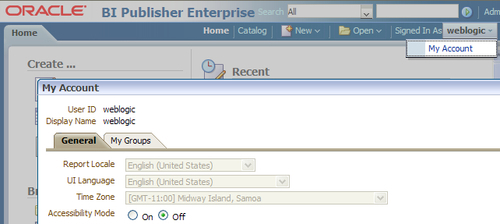You can use this type of translation when you want all the objects that BI Publisher includes to be translated. This feature allows translation of the following:
Report layouts
Catalog object descriptions
Report parameter's names
Data display names
It is a good choice to use catalog translation when the users working with BI Publisher use a language other than English. Users viewing the catalog will see the item translations appropriate for the UI Language and report translations appropriate for the Report Locale they selected in their My Account preferences.
On the home page of BI Publisher, click on the My Account link found under your username, to set your preferences. This is shown in the following screenshot:

Your preferences may be inherited from another Oracle product. In this case, you cannot update your preferences from within BI Publisher. This is one of the situations captured in the preceding image.
For a catalog translation perform the following steps:
In BI Publisher, open the catalog and select the folder to be translated.
Click on the Translation icon shown in the following screenshot and select the Export XLIFF menu option.
Save the
.xlffile in a folder of your choice:
Open the XLIFF file using a text editor. It will look like the following screenshot:

Change the
target-languageattribute of the<file>tag with the target language code.Provide a translation for the text contained by the
<source>tags. You have to enter the translation between the corresponding<target>tags.This file also contains object names and not only text strings contained by these objects, as you can see in the following screenshot:

Notice that opening the file in MS Word 2007—as shown in the following image—will generate a simplified version, not allowing attribute changing or viewing. But at the same time, simpler is better when you only need
<source>and<target>tags to enter the translation and your work will be ready in no time:
Upload the translated file back to BI Publisher.
Click on the Translation icon and go to the Import XLIFF menu option. This will open the Upload dialog window. Browse for the file containing the catalog translation and click on Upload:




